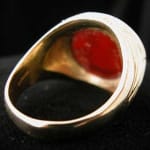Gold Ring with Classical Revival Carnelian Intaglio of a Deity and a Lion, 18th Century CE
GCarnelian and Gold
FJ.6889
The art of glyptics, or carving on colored precious stones, is probably one of the oldest known to humanity. Intaglios, gems with an incised design, were made as early as...
The art of glyptics, or carving on colored precious stones, is probably one of the oldest known to humanity. Intaglios, gems with an incised design, were made as early as the fourth and third millennia B.C. in Mesopotamia and the Aegean Islands. They exhibit a virtuosity of execution that suggests an old and stable tradition rooted in the earliest centuries. The tools required for carving gems were simple: a wheel with a belt-drive and a set of drills. A special difficulty of engraving intaglios, aside from their miniature size, was that the master had to work with a mirror-image in mind.
The Classical Revival was a phenomenon that swept through Europe in the 18th and 19th Centuries. A new appreciation for antiquity and ancient art forms was fostered by discoveries in the nascent scientific field of archaeology. Perhaps the Classical Revival also reveals a latent longing towards the Arcadian lifestyles of yesterday abandoned as Europe became rapidly industrialized and increasingly urbanized. Engraved upon the polished surface of this precious gemstone is an unusual pairing. On the right side, facing right, is the head of a deity or an emperor. A filet, the ancient mark of leadership, has been tied around his curly hair. On the left side, facing left, is the head of a lion, with curly mane. Lion, the so-called kings of the jungle, have been associated with the ruling elite since the dawn of civilization. It is unlikely that this is a representation of a specific god or emperor. His facial features are far too idealized to convey a personal identification. Instead, this intaglio is a romantic fantasy of the past that continues to intrigue today.
The Classical Revival was a phenomenon that swept through Europe in the 18th and 19th Centuries. A new appreciation for antiquity and ancient art forms was fostered by discoveries in the nascent scientific field of archaeology. Perhaps the Classical Revival also reveals a latent longing towards the Arcadian lifestyles of yesterday abandoned as Europe became rapidly industrialized and increasingly urbanized. Engraved upon the polished surface of this precious gemstone is an unusual pairing. On the right side, facing right, is the head of a deity or an emperor. A filet, the ancient mark of leadership, has been tied around his curly hair. On the left side, facing left, is the head of a lion, with curly mane. Lion, the so-called kings of the jungle, have been associated with the ruling elite since the dawn of civilization. It is unlikely that this is a representation of a specific god or emperor. His facial features are far too idealized to convey a personal identification. Instead, this intaglio is a romantic fantasy of the past that continues to intrigue today.



